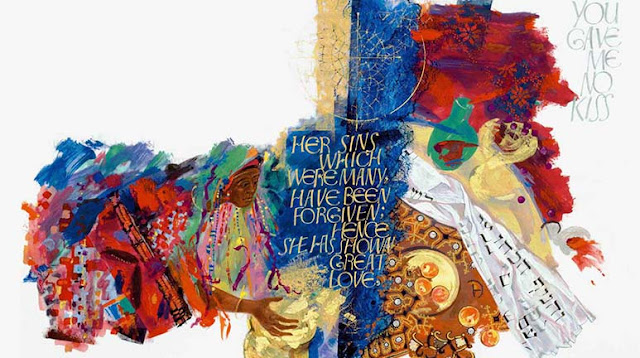He’s the Queen’s scribe, the man–the artist–responsible for creating England’s most important state documents. He’s the royal calligrapher, an artist, a past chair of the Society of Scribes and Illuminators (a word so rare my spellcheck red-lines it).
He’s a Brit of course, and he carries levels of sophistication capable of leaving Yanks like me stuttering in envy, despite our 250-year-old revolutionary history.
Oddly, however, the story he relishes telling is of a Minnesota morning walk to a place where the St. John’s campus map told him there once was a Indian burial ground. There, still in the quiet of pre-dawn, a fawn stepped out of the woods, simply stood and looked at him until her mother came along and unhurriedly drew her back into cover.
Just then, as the sun rose and a shadow moved across the ground beneath his feet, he looked up to see a crow passing over. Documenting spiritual experience is impossible, even for the English, as it has been since human beings began seeing visions; but the Queen’s scribe, Donald Jackson, says he felt, right then, in Collegeville, Minnesota, perfectly at one with nature.
He claims he carried that transcendent moment into the meeting for which he’d come to St. John’s, a meeting to determine how this grand idea of his–and others–would come to pass. The highest art for a true calligrapher, he’d long thought, would be a holy scripture. In a newly fashioned but old-fashioned way, he wanted to create a new Holy Bible, as the Benedictine monks had done for centuries.
That bible, the St. John’s Bible, is something unlike anything you’ve ever seen. Today, it has its own museum there on the St. John’s campus. As the monks at the abbey like to say, that Bible “ignites the imagination.”
With the same dynamic relationship that existed between medieval Benedictine houses and the scribes whose talents they engaged, Saint John’s Abbey and University and calligrapher Donald Jackson, in collaboration with many from the wider community, produced a Bible, a work of art, which serves to ignite the spiritual imagination of believers throughout the world.Yes it does. It’s not quick and easy, and it’s huge–two feet tall and three-feet wide.
The St. John’s Bible won’t fit neatly into a sport-coat pocket or slip into a motel drawer. It has 1100 pages of paper thicker than anything in your or my library. Each page is 24 ½” x 15 7/8”, which means a two-page spread is three feet wide. You can’t pull it out of a rucksack at a campfire.
But then, consider this: the only place in the world you’ll find its particular script will be within its pages, since Donald Jackson designed its lettering specifically for this volume alone. In addition, the St. John’s Bible has 160 illustrations–and illustrations pitiably understates what’s there because those 160 visual pieces are individual works of art as striking as they are demanding. Warner Sallman’s Head of Christ (1940) isn’t here. That famous painting has its place, but not in the St. John’s Bible. Here’s a dinner with the Pharisees.
Everything about the book St. John’s created is stunning. To the making of books, it is what the Sistine Chapel is to architecture. Protestantism has worked hard to destroy images, but often mistaken grace for idolatry. To a world who seeks it, the St. John’s Bible preaches nothing less than beauty.
If you’re in the neighborhood, stop by and see for yourself. You can call the trip a pilgrimage if you’d like, because it will be.
Still, if you watch the video, the Queen’s own scribe can’t help but smile when he remembers how, once upon a time in a morning walk through an Indian burial ground just outside of St. Cloud, Minnesota, he felt himself totally alive in the eyes of a fawn and the flight of a crow and the face of a rising sun. That pre-dawn transcendent moment was itself a birthplace, he says.
 |






The St. John’s Bible is so important to me, I collected the print versions as well as the supplementary materials! But my deepest responses have happened in the presence of the originals. They move me to tears for some reason. This work is not only a masterpiece, it is a treasure. Thank you for describing its beauty as well as the mastery and mystical experience of Donald Jackson.